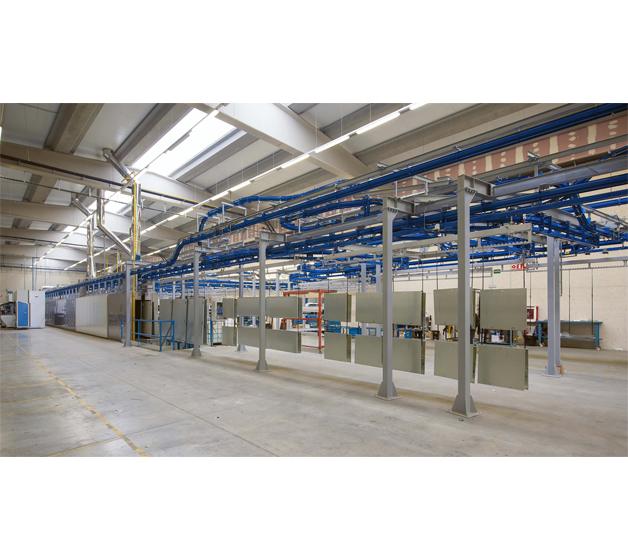 04 October, 2016
04 October, 2016The Navarre company, Exkal, Tecnología Electrostática e Industria del Metal, S. L., located in Marcilla, ordered from Geinsa a complete painting installation for finishing its products. The order included three basic phases: project, manufacture and installation.
This industrial painting installation incorporated, among other equipment, a surface treatment tunnel with degreasing / hot nanotechnology phases; washing with osmotised water; passivating at ambient temperature; osmotised water equipment and oil separator.
Furthermore, the installation included a humidity drying oven; gel oven, paint polymerisation oven; chain for overhead transport and electrical box with general synoptic, PLC and touch screen.
Noteworthy is the surface treatment tunnel, where the part treatment processes take place. A series of zones have been enabled for this, where the aspersion ramps are installed and where the aspersion of the different solutions takes place.
This is a closed area – 36,500 mm long, 1,400 mm wide and 3,900 high – coated with stainless steel plate, eliminating any possible of rust forming. The structure is made up of sheet metal panels that are assembled by means of a special construction system without welding.
It has a closure system on the roof, by means of brushes, preventing vapours and steam from affecting the transport chain. It has three intermediate doors to access the tunnel with platform, stairs and handrail.
There are two forced and direct blowing devices at the exit from the tunnel, to roughly eliminate water particles from the surface of the parts, in order to remove as much water as possible that has deposited on the surface of the parts before they are placed in the humidity drying oven.
Both the sides of the tunnel, and the sides of the vats are insulated with mineral rock wool to insulate the hot zones.
In the oil separator, the water with thick oil is taken through the pump to the equipment where the separation between oily and aqueous phases takes place.
Finally, the paint installation for Exkal has an electric control panel that includes touch screen and synoptic to illustrate the entire installation, where the operating elements of the line are displayed by means of LED lights that flash on and off when there is a fault.
Both the humidity drying oven and the polymerisation oven are made of mineral rock wool that adapt to their needs in terms of thickness and density. Direct fired burners are installed in the humidity drying oven, whilst the polymerisation oven houses indirect fired modulating burners by means of a combustion chamber in refractory stainless steel AISI-310.
Subscribe to our newsletter. Just insert your e-mail and you will receive the latest news.